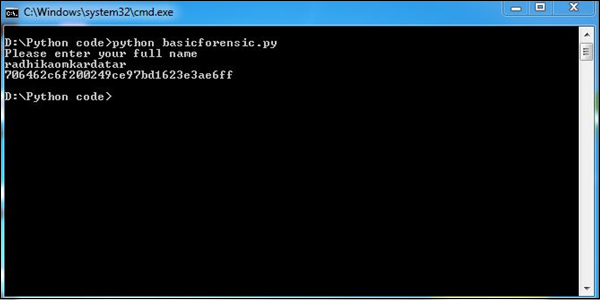📌 相关文章
- 取证 (1)
- Python取证-网络取证
- Python取证-网络取证(1)
- Python取证-移动取证(1)
- Python取证-移动取证
- Python取证-内存和取证
- Python取证-内存和取证(1)
- Linux中的Python取证
- Linux中的Python取证(1)
- 取证 - 任何代码示例
- Python取证-索引
- Python取证-索引(1)
- 网络取证
- 网络取证(1)
- Python取证-搜索
- Python取证-搜索(1)
- Python取证-安装Python(1)
- Python取证-安装Python
- Python取证教程
- Python取证教程(1)
- Python取证-云的实现(1)
- Python取证-云的实现
- Python取证-简介
- Python取证-简介(1)
- 讨论Python取证(1)
- 讨论Python取证
- Python取证Python模块
- Python取证Python模块(1)
- Python数字网络取证-I
📜 Python取证-基本取证应用
📅 最后修改于: 2020-11-06 05:27:41 🧑 作者: Mango
对于根据法医准则创建应用程序,了解并遵循其命名约定和模式非常重要。
命名约定
下表描述了在开发Python取证应用程序时要遵循的规则和约定。
| Constants | Uppercase with underscore separation | HIGH_TEMPERATURE |
| Local variable name | Lowercase with bumpy caps (underscores are optional) | currentTemperature |
| Global variable name | Prefix gl lowercase with bumpy caps (underscores are optional) | gl_maximumRecordedTemperature |
| Functions name | Uppercase with bumpy caps (underscores optional) with active voice | ConvertFarenheitToCentigrade(…) |
| Object name | Prefix ob_ lowercase with bumpy caps | ob_myTempRecorder |
| Module | An underscore followed by lowercase with bumpy caps | _tempRecorder |
| Class names | Prefix class_ then bumpy caps and keep brief | class_TempSystem |
让我们以一个场景来理解在计算取证中命名约定的重要性。假设我们有一个通常用于加密数据的哈希算法。单向哈希算法将输入作为二进制数据流。这可以是密码,文件,二进制数据或任何数字数据。然后,哈希算法针对输入中接收到的数据生成消息摘要(md)。
创建新的二进制输入来生成给定的消息摘要实际上是不可能的。即使更改了二进制输入数据的单个位,也将生成唯一的消息,该消息与前一个不同。
例
看一下遵循上述约定的以下示例程序。
import sys, string, md5 # necessary libraries
print "Please enter your full name"
line = sys.stdin.readline()
line = line.rstrip()
md5_object = md5.new()
md5_object.update(line)
print md5_object.hexdigest() # Prints the output as per the hashing algorithm i.e. md5
exit
上面的程序产生以下输出。

在此程序中, Python脚本接受输入(您的全名)并根据md5哈希算法将其转换。如果需要,它会加密数据并保护信息。根据法医指南,可以以这种方式确保证据名称或任何其他证据的安全。